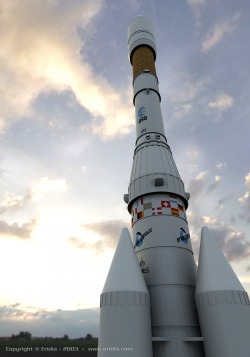ariane 3

Ariane 3 was a Europeanexpendablecarrier rocket, which was used for six launches between 1986 and 1989. It was a member of the Ariane family of rockets, derived from the Ariane 2, although it flew before this. It was designed by the Centre National d'Etudes Spatiales, and produced by Aérospatiale in France.
The Ariane 3 followed the same basic design as the earlier Ariane 1, but incorporated modifications made for the Ariane 2, including stretched first and third stages, and uprated first and second stage engines. It also featured the larger payload fairing flown on the Ariane 2. Unlike the Ariane 2, two solid-fuelledPAPstrap-on booster rockets were used to augment the first stage at liftoff.
The core of the Ariane 3 was essentially an Ariane 2. The first stage was powered by four Viking 2Bbipropellant engines, burning Nitrogen tetroxide in an UH 25 oxidiser, which was a mixture of three parts UDMH and one part Hydrazine. The second stage was powered by a Viking 4B, which used the same fuel-oxidiser combination. The third stage used a cryogenically-fuelledHR7-B engine, burning liquid hydrogen in liquid oxygen. On some flights, a Mage 2kick motor was flown as a fourth stage.
Launch history The Ariane 3 made its maiden flight on 4 August 1984, almost two years before Ariane 2 from which it had been derived, placing the ECS-2 and Télécom 1A satellites into geosynchronous transfer orbit. Eleven were launched with ten successes and one failure. The failure occurred on the fifth flight, launched on 12 September 1985, when the third stage failed to ignite resulting in the rocket failing to achieve orbit. The ECS-3 and Spacenet-3 satellites were lost in the failure.
The Ariane 3 was quickly replaced by the more capable Ariane 4, resulting in a comparatively small number of launches. It made its final flight on 12 July 1989, carrying the Olympus F1 satellite.
The Ariane 3 followed the same basic design as the earlier Ariane 1, but incorporated modifications made for the Ariane 2, including stretched first and third stages, and uprated first and second stage engines. It also featured the larger payload fairing flown on the Ariane 2. Unlike the Ariane 2, two solid-fuelledPAPstrap-on booster rockets were used to augment the first stage at liftoff.
The core of the Ariane 3 was essentially an Ariane 2. The first stage was powered by four Viking 2Bbipropellant engines, burning Nitrogen tetroxide in an UH 25 oxidiser, which was a mixture of three parts UDMH and one part Hydrazine. The second stage was powered by a Viking 4B, which used the same fuel-oxidiser combination. The third stage used a cryogenically-fuelledHR7-B engine, burning liquid hydrogen in liquid oxygen. On some flights, a Mage 2kick motor was flown as a fourth stage.
Launch history The Ariane 3 made its maiden flight on 4 August 1984, almost two years before Ariane 2 from which it had been derived, placing the ECS-2 and Télécom 1A satellites into geosynchronous transfer orbit. Eleven were launched with ten successes and one failure. The failure occurred on the fifth flight, launched on 12 September 1985, when the third stage failed to ignite resulting in the rocket failing to achieve orbit. The ECS-3 and Spacenet-3 satellites were lost in the failure.
The Ariane 3 was quickly replaced by the more capable Ariane 4, resulting in a comparatively small number of launches. It made its final flight on 12 July 1989, carrying the Olympus F1 satellite.
